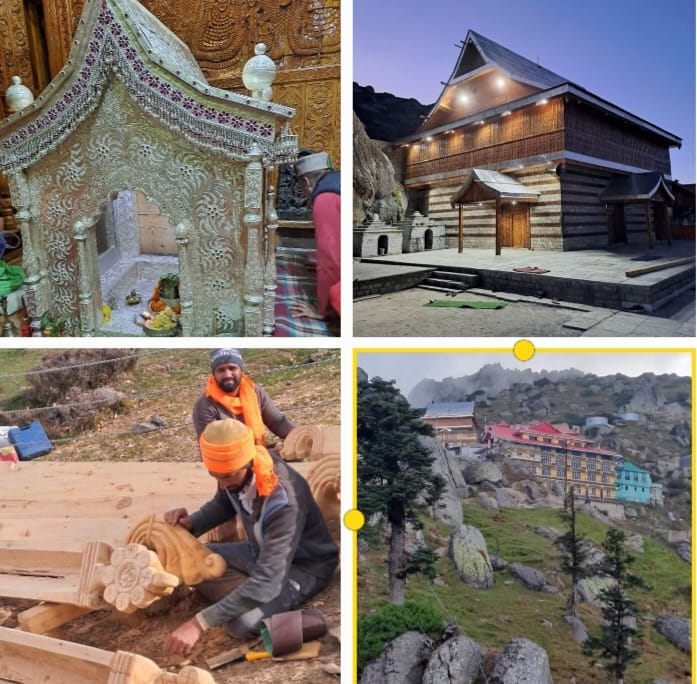Choorhdhar: After 52 long years, the ancient legend of Shirgul Maharaj and his brother Bijjat, devoted followers of Lord Shiva, has come alive here.
Thousands of devotees gathered from over 100 panchayats. They came from regions like Sarahan-Hambal, Chopal, Balson, Jakholi, Pulbahal, Shillai, Rajgarh, Paonta, and Sangrah in Himachal’s Sirmaur district, as well as Jaunsar Bawar and Janpur in Uttarakhand.
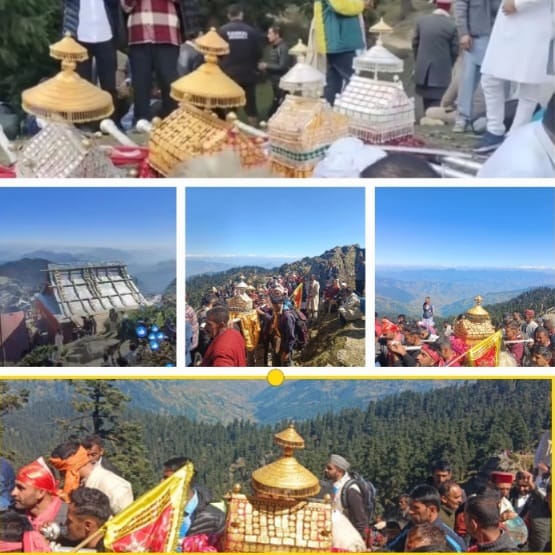
As many as five devtas including Bijjat of Sharahan arrived for the Shant mahaygya performed to enshrine seven Kuruds on the temple tops of the seven Shikhars of the Shiv Temple here.
Enchanting war cries of Shirgul, the devotees flooded the Kalabagh, the lush open ground that showcase legendary rocks and boulders telling the story of their lord.

They camped there for the night as the temple premises cannot accommodate more than 7000 people as their number was over 20,000 to 30,000 coming from both sides of the Choorh peak.
They have been converging to the sacred Shiv mountain for the Shant Mahayagya, a grand religious gathering for last over a week. The last Shant ceremony here was held about 52 years ago.
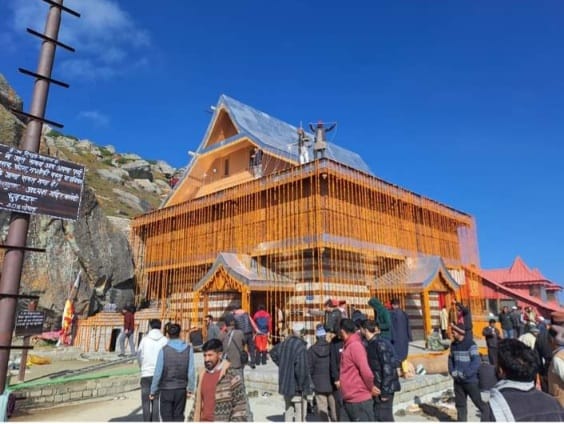
The Mahayagya not only marked the consecration of the revamped temple complex. It also also revived the legendary meeting of the royal family of King Bhukru, his wife Dudma Rani, parents of Shirgul, and his trusted friend Goga Pir, alongside his adopted sister, Devi Bhaganyani, whose temple stands at a cliff near Haripurdhar in Sirmaur.
Shirgul and Bijjat are revered across the region, with over a hundred big or small temples dedicated to them in Shimla, Sirmaur, and Solan districts of Himachal Pradesh and the Jaunsar Bawar and Janpur regions of Uttarakhand.
A highlight of the Mahayagya was Bijjat Devta’s grand journey from Sarahan, accompanied by thousands of devotees.
The occasion brought to life the legendary tale of Shirgul, once king of the tiny Shaya kingdom in Rajgarh, who built the Mahadev temple after a daring escape from Mughal captivity in Delhi.
According to legend, Shirgul was imprisoned by the Mughals in the mid-16th century. His "fault" was that he defended the Haattis of Sirmaur against exploitation and for slaying butchers caught slaughtering a cow in Delhi.
A sweeper woman, Bhaghayni, sent word to Shirgul’s ally, Goga Pir, who led a covert mission to free Shirgul from prison. Together, they returned safely to the hills.
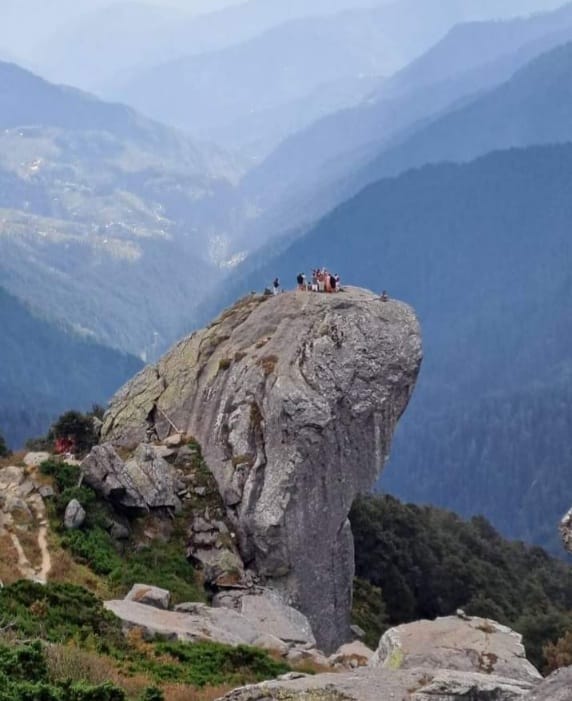
Once back, Shirgul found a demon threatening the life of Churu, a devotee, and his family at Choorhdhar. Joined by Bijjat, the two brothers decimated the demon, saving Churu, who is also now worshipped as a deity in the region.
Shirgul, deeply devoted to Lord Shiva, established the Mahadev temple at Choorhdhar, which houses a life-size Shivling and two idols.
It is believed that Shirgul later distributed his kingdom to his trusted minister, Deviram, and his third brother Brijeswar.
Shirgul dedicated his life to meditating and worshipping Lord Shiva at the Mahadev temple here. Both Shirgul and Bijjat mysteriously disappeared after 200 years of spiritual devotion at Choorhdhar.
The revamped temple complex, unveiled through the week-long Shant Mahayagya, culminated in the installation of beautifully carved deodar-Kurud atop the temple.
The Kuruds were crafted by divine artisans known as Badis, who brought the temple to life with their intricate carvings. These unsung heroes left their artistic mark, elevating the temple’s grandeur.
The Mahayagya saw participation from local temple committees, including the Seva Samiti and the Mandir Committee under SDM Chopal. The Sevadars organized logistics for the pilgrimage.
Devotees trekked up the towering mountain via multiple routes from Sarhan-Chopal, Pulbahal, Chehta-Kupvi and Haripur-Nauhradhar to be part of the sacred gathering.
Choorhdhar, standing tall at nearly 11,870 feet, is not just a spiritual destination, but also a geological wonder and a wild life sanctuary.
The legends of Shirgul and Bijjat resonate deeply here. The devotees find here Shauni Ghori, mare of the Shirgul, Asur Ki J Kanali, the utensil used by the demon and mysterious routes and caves.
A massive rock near the temple is still worshipped as the site where Churu and his family were saved.
The Shant Mahayagya concluded with the Puran Aahutis, performed by the traditional Yajmaans of Lord Shirgul.
The gathering reaffirmed the deep-rooted cultural and spiritual connections of the local communities with their deities, bringing the legend of Shirgul Maharaj and Bijjat back to life in all its grandeur.
Choorhdhar, towering over the Yamuna plains, Kurukshetra, and even Delhi, is said to be the spot from where Lord Shiva watched the Mahabharata war unfold. He can see his Abode, Kailash Parbat, Kedaranath and Badrinath from here.
Lord Shirgul has dropped sacred Gadus(water Pots) in these scared Peaks himself.
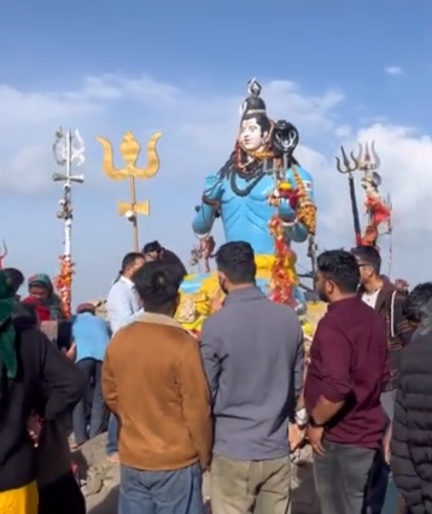
Rajput families in the region maintain the tradition of bringing their children to Choorhdhar for the sacred ritual of cutting their Choortha (a symbolic lock of hair) as an offering to Lord Chooreshwar when they come of age- a ritual practice as good as abandoned now.
This revival of ancient traditions at Choorhdhar has reawakened the spiritual essence of this sacred mountain, marking a significant religious milestone for devotees from across the region.
The devotees sought divine blessing for Lord Shiv at the Mandir and enjoy Bhandara served by the Sevadars of the Choorhdhar Seva Samiti before they start their journey back home blessed and elated.



